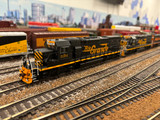Creating Your Model Railroad: Step-by-Step Guide to Laying Track
Model railroading is a fascinating hobby that allows enthusiasts to recreate miniature worlds of rail travel. One of the most critical aspects of building your model railroad is laying the track. Whether you're a beginner or a seasoned hobbyist, here's a step-by-step guide to help you lay your model railroad track with precision and creativity.
1. Plan Your Layout: Before you start laying track, it's essential to have a clear plan for your model railroad layout. Consider factors like available space, desired scenery, and the type of trains you want to run. Sketch out your layout on paper or use specialized software to design the track arrangement.
2. Gather Your Materials: Ensure you have all the necessary materials before you begin. This includes track pieces, connectors, a track bed (such as cork or foam), a ruler or measuring tape, a pencil, a hobby knife, and any additional accessories like switches and crossings.
3. Prepare the Surface: Clean the surface where you'll be laying your track to ensure a smooth foundation. If you're using a track bed like cork or foam, cut it to fit your layout and glue it down using a suitable adhesive. This will provide cushioning and sound dampening for your track.
4. Lay Out Your Track Plan: Using your layout plan as a guide, start laying out the track pieces according to your design. Begin with the mainline tracks and then add sidings, spurs, and other features as per your layout. Use a ruler or measuring tape to ensure straight sections and gentle curves.
5. Connect the Track Sections: As you lay each track section, ensure the rails are properly aligned and securely connected. Depending on the type of track you're using, you may need to insert connectors or use rail joiners to join sections together. Double-check that the track pieces are aligned correctly to avoid derailments later on.
6. Install Switches and Crossings: If your layout includes switches (turnouts) or crossings, now is the time to install them. Follow the manufacturer's instructions carefully to ensure proper installation and smooth operation. Test each switch to make sure it functions correctly before moving on.
7. Secure the Track: Once all track sections are in place, secure them to the track bed using small nails or track pins. Be careful not to hammer too hard, as this could damage the track or create unevenness. Alternatively, you can use adhesive to fix the track in place.
8. Test for Smooth Operation: Before adding any scenery or structures, test your track for smooth operation. Run a locomotive and rolling stock around the layout to check for any issues such as tight curves, uneven track joints, or electrical connectivity problems. Make any necessary adjustments as you go.
9. Add Scenery and Details: With the track laid and tested, it's time to add scenery and details to bring your model railroad to life. This could include landscaping, buildings, trees, roads, and other elements that complement your chosen theme or era. Take your time to create realistic scenes that enhance the overall realism of your layout.
10. Enjoy Your Railroad: Once your model railroad is complete, sit back and enjoy the fruits of your labor. Whether you prefer to watch trains running through scenic landscapes or enjoy the satisfaction of building intricate dioramas, model railroading offers endless opportunities for creativity and relaxation.
By following these step-by-step instructions, you can lay your model railroad track with confidence and precision, setting the stage for countless hours of enjoyment ahead. Happy railroading!
Recent Posts
-
Capturing History in Miniature: The Art of Prototype Modeling in the Model Railroad World
Prototype modeling in the model railroad world involves creating miniature replicas of real-life tra
-
Unveiling the Imaginative World of Fictional Railroads: Where Creativity Meets the Rails
Model railroading has long been a hobby rooted in historical accuracy and meticulous attention to de
-
Creating Your Model Railroad: Step-by-Step Guide to Laying Track
Model railroading is a fascinating hobby that allows enthusiasts to recreate miniature worlds of rai




